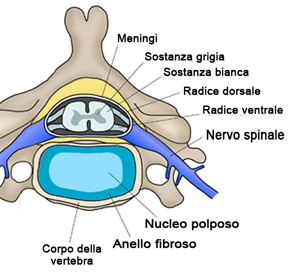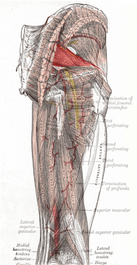RYING TO FIGURE OUT WHETHER YOUR BUTT PAIN / SCIATICA IS DISC OR PIRIFORMIS SYNDROME?
TRY THIS SIMPLE HOME TEST
DISC HERNIATION  | PIRIFORMIS SYNDROME  |


My guess is that you may have already read my posts on PIRIFORMIS OR DISC? and PIRIFORMIS SYNDROME OR SCIATICA?. Today I would like to provide you with a simple test that you can do at home to help you answer the question proposed in the title of this post —- is your pain due to PIRIFORMIS SYNDROME or is it due to DISC HERNIATION(S)? If you are planning on traveling to see me, this is an important question to attempt to answer beforehand —- particularly in light of OVERUSED MRI’S and ASYMPTOMATIC DISC HERNIATIONS. Although both of the problems in the diagrams above can cause leg pain (SCIATICA), as you can see, that leg pain is arising from very different anatomical regions.
- PIRIFORMIS SYNDROME: The picture on the right is of a right buttock. The Sciatic Nerve (yellow) can be seen emerging from underneath the Piriformis Muscle (red) through a little window called “The Sciatic Notch” (see arrow). When the Sciatic Nerve is pinched or irritated in the vicinity of the Piriformis Muscle, the result is typically buttock pain or paresthesias (numbness, tingling, or other ‘odd’ sensations) that radiates down the leg in a fairly unpredictable pattern. Due to the fact that anomalies of the Piriformis / Sciatic region are so common (Sciatic Nerves can travel around or even through the Piriformis Muscle in a wide variety of ways), you will need to prod around several areas on the buttocks to make sure that you are getting the correct spot.
- DISC HERNIATION: The animation on the left is of a disc herniation that is pressing on a nerve root. Because all of the nerve roots from your lower back region grow together into one large nerve (the Sciatic Nerve), the pain is not only typically found locally — at the site of the Herniation —- but it has the ability to travel into the leg in similar fashion to Piriformis Syndrome (you can begin to see why these can be so difficult to differentiate from one another). Just be aware that this Disc-based Sciatica has the ability to manifest in numerous ways. Neither is it terribly uncommon for people to have Disc-based Sciatica without having local pain in their back.
TESTING THE PIRIFORMIS AGAINST THE DISC
(As you should gather from the bullet points above, this method is in no ways fool-proof.)
One way to try and determine whether or not your problem is Piriformis Syndrome or Disc Herniation is to firmly probe both areas (if you are not firm, you may not elicit a pain response). In most cases of Piriformis Syndrome, I can reproduce the buttock pain / Sciatica, simply by sticking a thumb into the region at or around the end of the arrow (see diagram above right). Mind you, this will need to be done with firmness. Now we move up to the lumbar spine (2-4 inches above the top of the butt crack) and firmly press a thumb into this region as well (you are probably going to have to have a spouse or friend do this for you — it will be all but impossible for you to press firmly enough on your own backside).
If you cannot elicit Sciatica or low back pain by pressing firmly in and around the lumbar spine, and you can cause buttock pain and / or Sciatica by pressing firmly into the buttock area, your problem is more likely to be Piriformis Syndrome. If, on the other hand, you firmly press into the low back and elicit local pain and Sciatica, your problem is more likely to be Disc-related. This simple test is not fool-proof by any means. Furthermore, it will not provide the sought after information unless the person doing the test really presses in with some firmness.
Also, when some degree of slipped disc is present, there will usually be some very specific signs. Although these are not always in and of themselves linked to disc, when they are seen together, your chances that your problem is disc-related are certainly greater. They are AS FOLLOWS.
One other tidbit I might mention along these lines has to do with INVERSION THERAPY. First, let me say that although I do not sell the tables, I am a huge fan as there is tremendous potential for helping the low back pain and sciatica caused by a disc issue. However, it is important to be aware that in my experience, most of the time it tends to aggravate Piriformis Syndrome.
